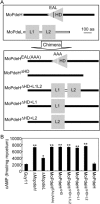New findings on phosphodiesterases, MoPdeH and MoPdeL, in Magnaporthe oryzae revealed by structural analysis
- PMID: 28752677
- PMCID: PMC6638029
- DOI: 10.1111/mpp.12586
New findings on phosphodiesterases, MoPdeH and MoPdeL, in Magnaporthe oryzae revealed by structural analysis
Abstract
The cyclic adenosine monophosphate (cAMP) signalling pathway mediates signal communication and sensing during infection-related morphogenesis in eukaryotes. Many studies have implicated cAMP as a critical mediator of appressorium development in the rice blast fungus, Magnaporthe oryzae. The cAMP phosphodiesterases, MoPdeH and MoPdeL, as key regulators of intracellular cAMP levels, play pleiotropic roles in cell wall integrity, cellular morphology, appressorium formation and infectious growth in M. oryzae. Here, we analysed the roles of domains of MoPdeH and MoPdeL separately or in chimeras. The results indicated that the HD and EAL domains of MoPdeH are indispensable for its phosphodiesterase activity and function. Replacement of the MoPdeH HD domain with the L1 and L2 domains of MoPdeL, either singly or together, resulted in decreased cAMP hydrolysis activity of MoPdeH. All of the transformants exhibited phenotypes similar to that of the ΔMopdeH mutant, but also revealed that EAL and L1 play additional roles in conidiation, and that L1 is involved in infectious growth. We further found that the intracellular cAMP level is important for surface signal recognition and hyphal autolysis. The intracellular cAMP level negatively regulates Mps1-MAPK and positively regulates Pmk1-MAPK in the rice blast fungus. Our results provide new information to better understand the cAMP signalling pathway in the development, differentiation and plant infection of the fungus.
Keywords: MoPdeH/L; appressorium formation; cAMP level; pathogenicity; phosphodiesterase activity.
© 2017 BSPP AND JOHN WILEY & SONS LTD.
Figures











Similar articles
-
Phosphodiesterase MoPdeH targets MoMck1 of the conserved mitogen-activated protein (MAP) kinase signalling pathway to regulate cell wall integrity in rice blast fungus Magnaporthe oryzae.Mol Plant Pathol. 2016 Jun;17(5):654-68. doi: 10.1111/mpp.12317. Epub 2015 Dec 2. Mol Plant Pathol. 2016. PMID: 27193947 Free PMC article.
-
The adenylate cyclase UvAc1 and phosphodiesterase UvPdeH control the intracellular cAMP level, development, and pathogenicity of the rice false smut fungus Ustilaginoidea virens.Fungal Genet Biol. 2019 Aug;129:65-73. doi: 10.1016/j.fgb.2019.04.017. Epub 2019 May 4. Fungal Genet Biol. 2019. PMID: 31063805
-
The Putative Protein Phosphatase MoYvh1 Functions Upstream of MoPdeH to Regulate the Development and Pathogenicity in Magnaporthe oryzae.Mol Plant Microbe Interact. 2016 Jun;29(6):496-507. doi: 10.1094/MPMI-11-15-0259-R. Epub 2016 Apr 25. Mol Plant Microbe Interact. 2016. PMID: 27110741
-
Cyclic AMP synthesis and hydrolysis in the normal and failing heart.Pflugers Arch. 2014 Jun;466(6):1163-75. doi: 10.1007/s00424-014-1515-1. Epub 2014 Apr 24. Pflugers Arch. 2014. PMID: 24756197 Review.
-
Making and Breaking of an Essential Poison: the Cyclases and Phosphodiesterases That Produce and Degrade the Essential Second Messenger Cyclic di-AMP in Bacteria.J Bacteriol. 2018 Dec 7;201(1):e00462-18. doi: 10.1128/JB.00462-18. Print 2019 Jan 1. J Bacteriol. 2018. PMID: 30224435 Free PMC article. Review.
Cited by
-
MoImd4 mediates crosstalk between MoPdeH-cAMP signalling and purine metabolism to govern growth and pathogenicity in Magnaporthe oryzae.Mol Plant Pathol. 2019 Apr;20(4):500-518. doi: 10.1111/mpp.12770. Epub 2019 Jan 11. Mol Plant Pathol. 2019. PMID: 30426699 Free PMC article.
-
The rice blast fungus MoRgs1 functioning in cAMP signaling and pathogenicity is regulated by casein kinase MoCk2 phosphorylation and modulated by membrane protein MoEmc2.PLoS Pathog. 2021 Jun 16;17(6):e1009657. doi: 10.1371/journal.ppat.1009657. eCollection 2021 Jun. PLoS Pathog. 2021. PMID: 34133468 Free PMC article.
-
MoLrp1-mediated signaling induces nuclear accumulation of MoMsn2 to facilitate fatty acid oxidation for infectious growth of the rice blast fungus.Plant Commun. 2023 Jul 10;4(4):100561. doi: 10.1016/j.xplc.2023.100561. Epub 2023 Feb 11. Plant Commun. 2023. PMID: 36774535 Free PMC article.
References
-
- Arnold, K. , Bordoli, L. , Kopp, J. and Schwede, T. (2006) The SWISS‐MODEL workspace: a web‐based environment for protein structure homology modelling. Bioinformatics, 22, 195–201. - PubMed
-
- Bencina, M. , Panneman, H. , Ruijter, G.J. , Legisa, M. and Visser, J. (1997) Characterization and overexpression of the Aspergillus niger gene encoding the cAMP‐dependent protein kinase catalytic subunit. Microbiology, 143, 1211–1220. - PubMed
-
- Biasini, M. , Bienert, S. , Waterhouse, A. , Arnold, K. , Studer, G. , Schmidt, T. , Kiefer, F. , Gallo Cassarino, T. , Bertoni, M. , Bordoli, L. and Schwede, T. (2014) SWISS‐MODEL: modelling protein tertiary and quaternary structure using evolutionary information. Nucleic Acids Res. 42, W252–W258. - PMC - PubMed
-
- Bobrov, A.G. , Kirillina, O. and Perry, R.D. (2005) The phosphodiesterase activity of the HmsP EAL domain is required for negative regulation of biofilm formation in Yersinia pestis . FEMS Microbiol. Lett. 247, 123–130. - PubMed
Publication types
MeSH terms
Substances
LinkOut - more resources
Full Text Sources
Other Literature Sources
Research Materials

